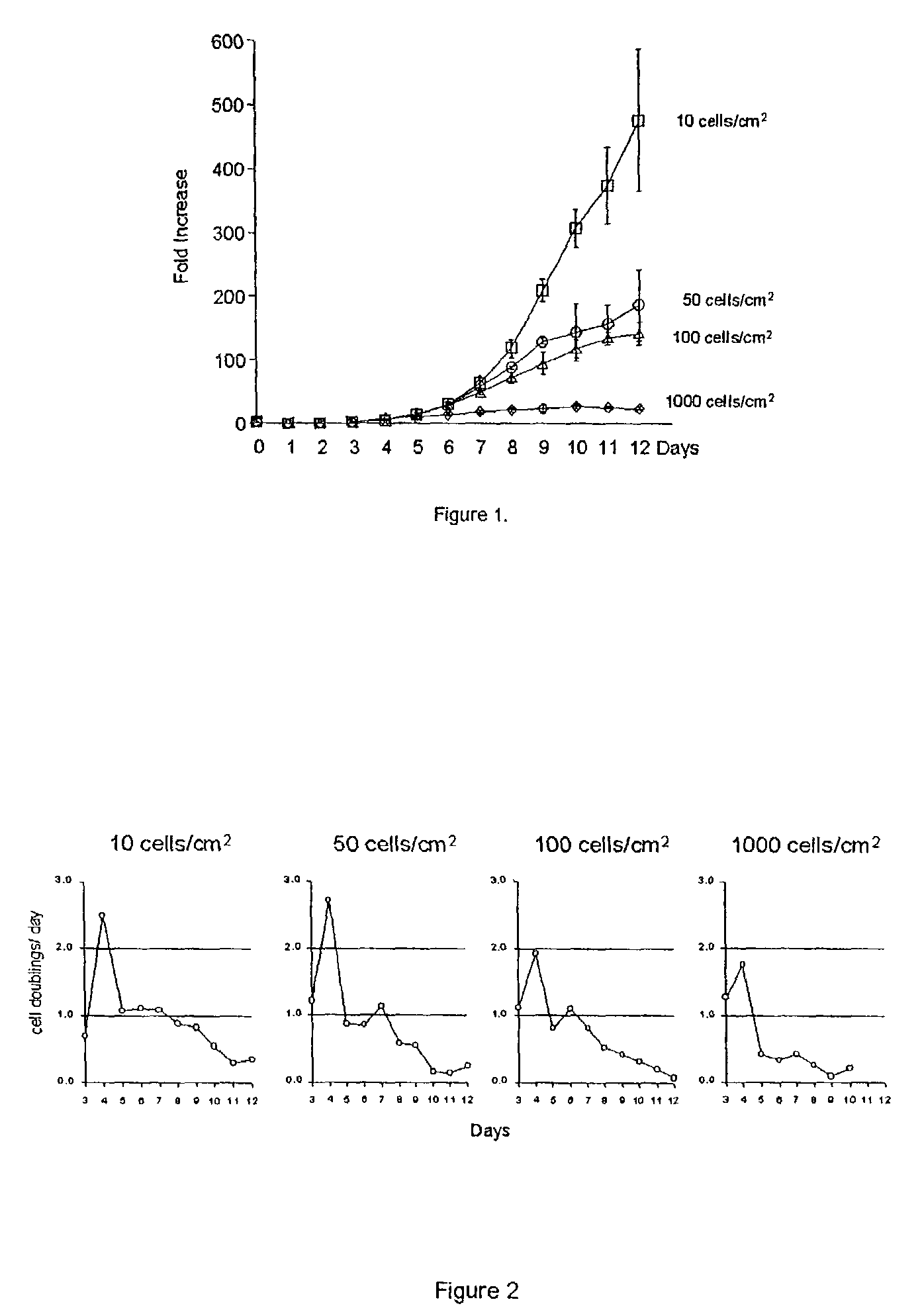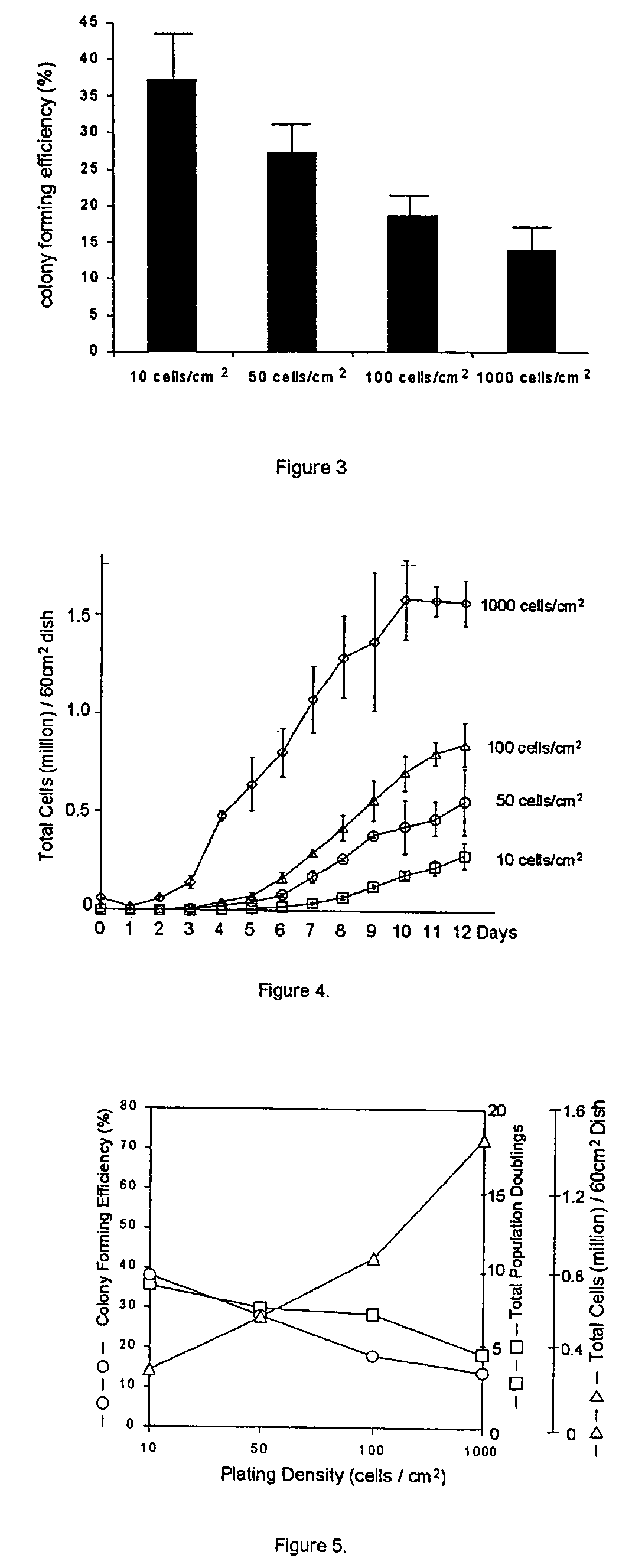Enhanced growth of adult stem cells with Dkk-1
a stem cell and adult technology, applied in the field of enhanced growth of adult stem cells with dkk-1, can solve the problems of mscs losing their proliferative capacity and their potential to differentiate, and achieve the effect of improving culture conditions and enhancing mscs
- Summary
- Abstract
- Description
- Claims
- Application Information
AI Technical Summary
Benefits of technology
Problems solved by technology
Method used
Image
Examples
example 1
Standardization for Characterizing MSCs
[0115]The materials and Methods used in the experiments presented in this Example are now described.
[0116]Isolation and Cultures of Human MSCs
[0117]To isolate human MSCs, 2 to 10 milliliters of bone marrow aspirates were taken from the iliac crest of normal adult donors after informed consent and under a protocol approved by an Institutional Review Board. Nucleated cells were isolated with a density gradient (Ficoll-Paque, Pharmacia, Piscataway, N.J.) and resuspended in complete culture medium (alpha-MEM, GIBCO BRL; 20% fetal bovine serum, FBS lot-selected for rapid growth of MSCs (Atlanta Biologicals, Norcross, Ga.) 100 units per milliliter penicillin; 100 micrograms per milliliter streptomycin; and 2 millimolar L-glutamine, (GIBCO BRL, Rockville, Md.).
[0118]All of the nucleated cells were plated in 20 milliliters of medium in a culture dish and incubated at 37° C. with 5% CO2. After 24 hours, non-adherent cells were discarded, and adherent ce...
example 2
Enhanced Method for Characterizing RS Cells
[0144]The Materials and Methods used in the experiments presented in this Example are now described.
[0145]Human MSCs were prepared as described above.
[0146]All the nucleated cells (30 to 70 million) were plated in a 145 cm2 dish in 20 milliliters complete medium: alpha-MEM (GIBCO BRL, Rockville, Md.); 20% fetal bovine serum, FBS lot-selected for rapid growth of MSCs (Atlanta Biologicals, Norcross, Ga.); 100 units per milliliter penicillin; 100 micrograms per milliliter streptomycin; and 2 millimolar L-glutamine (GIBCO BRL, Rockville, Md.). After 24 hours at 37° C. in 5% CO2, adherent cells were discarded and incubation in fresh medium was continued for 4 days. The cells were removed with 0.25% trypsin and 1 millimolar EDTA for 5 minutes at 37° C. and replated at 50 cells / cm2 in an interconnecting system of culture flasks (6320 cm2; Cell Factory, Nunc, Rochester, N.Y.). After 7 to 9 days, the cells were removed with trypsin / EDTA and in froze...
example 3
Dkk-1 Enhances Proliferation of MSCs
[0159]Bone Marrow Tissue culture
[0160]Bone marrow aspirates of about 2 milliliters were drawn from healthy donors ranging in age from 19 to 49 years under an Institutional Review Board approved protocol. Plastic adherent nucleated cells were separated from the aspirate and cultured as previously described in DiGirolamo et al., Br. J. Haematol. 107:275-281. After 14 days in culture, adherent cells were recovered from the monolayer by incubation with 0.25% (w / v) trypsin and 1 millimolar EDTA (Fisher Lifesciences; Pittsburgh, Pa.) for 5 to 7 minutes at 37° C. (Fisher Lifesciences; Pittsburgh, Pa.) and re-plated at a density of 100 cells per cm2.
[0161]The cells were then cultured for various times with a change of media every 2 to 3 days. Cells were radiolabeled at indicated intervals by addition of new media containing 5 microcuries per milliliter [35S]-labeled methionine (Amersham Pharmacia Biotech; Piscataway N.J.). The cultures were allowed to inc...
PUM
 Login to View More
Login to View More Abstract
Description
Claims
Application Information
 Login to View More
Login to View More - R&D
- Intellectual Property
- Life Sciences
- Materials
- Tech Scout
- Unparalleled Data Quality
- Higher Quality Content
- 60% Fewer Hallucinations
Browse by: Latest US Patents, China's latest patents, Technical Efficacy Thesaurus, Application Domain, Technology Topic, Popular Technical Reports.
© 2025 PatSnap. All rights reserved.Legal|Privacy policy|Modern Slavery Act Transparency Statement|Sitemap|About US| Contact US: help@patsnap.com



